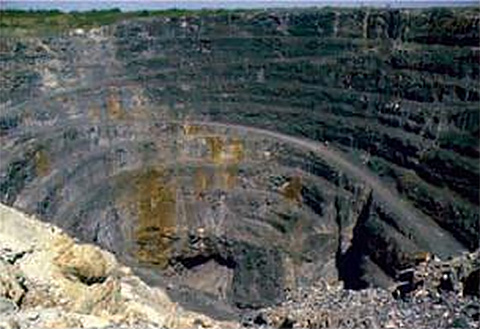
In one of the world’s deepest mines, scientists have discovered some of the world’s oldest water.
In northern Canada, the Kidd Creek Mine is almost 10,000 ft deep. Here, miners search for copper, zinc, and silver ore in volcanic material that was once the floor of an ancient sea.
At the very bottom of the mine, they drilled an exploratory borehole even farther down to look for more metal ore.
What they found was possibly the oldest water in the world, trapped in the rocks for more than 2 billion years.
Why is this important? It provides a snapshot of Earth from that far distant time before there was anything but single-celled life on the planet.
And what was water like then? Very different.
The water from this ancient sea is eight times saltier than today’s ocean water. Trapped in it are helium, argon, neon, krypton, and xenon gases.
And, surprisingly, sulfur isotopes which show that ancient single-celled organisms must have lived in it long ago.
Scientists are still analyzing this ancient water, in hopes of better understanding not only our juvenile Earth, but also the types of extreme environments we may find elsewhere, like on the moons of Saturn and Jupiter, where there are vast oceans of water trapped beneath ice sheets.
If basic life forms existed in our ancient water, without sunlight or any contact with the surface, it is possible we will find them in other places, too.
Background
Synopsis: Canadian scientists have discovered water with a 2-billion-year residence time flowing out of fractures deep in a mine. Its chemistry is unique and may provide clues about the primordial soup from which life is believed to have originated.
- The Kidd Creek Mine in Timmins, Ontario, Canada (north of the U.S. state of Michigan), is the deepest copper, zinc, and silver mine in the world, with excavation to more than 9,800-ft depth.
- The rich deposit is a massive sulfide ore deposit in 2.7-billion-year-old volcanic material from the ancient seafloor.
- Although seven other mines on Earth are deeper, the location of this mine at 48 degrees north latitude and its current depth of 9,800 ft probably makes the bottom of the mine the closest human-made access point to the center of Earth.
- In 2013, University of Toronto scientists announced a source of more than a 1-billion-year-old water in the mine, running from fractures in the rock at a depth of 2.4 km.
- To figure out the water’s age, scientists measured concentrations of gases—helium, argon, neon, krypton, and xenon—that built up in the water during the time it was trapped.
- In 2016, after the miners drilled boreholes down to nearly 3 km in search of more ore, they encountered water flowing at liters per minute from a deeper set of fractures; scientists discovered that the water had been preserved there for 2 billion years!
- All isotopic signatures found in water from this pool were even more extreme than those recorded from the shallower pool. And both sources of water were much different than Earth’s surface water.
- The water is eight times more saline than seawater and contains distinctive combinations of conservative elements like noble gases.
- Sulfates detected in the water must have been generated over a long time period by oxidation of sulfide minerals that make up the ore.
- Once delivered to the water as sulfate, sulfur-reducing single-celled organisms that must have lived in the water in the past were able to use this chemical energy to survive after the water was trapped 2 billion years ago.
- The search for any living organisms in the water today is ongoing, with recent evidence for the presence of modern-day sulfur-reducing organisms found in culture experiments carried out on the waters.
- Gaining a better understanding of deep, preserved fossil water and “geobiology” on Earth provides concepts that aid exploration for life elsewhere in the universe.

